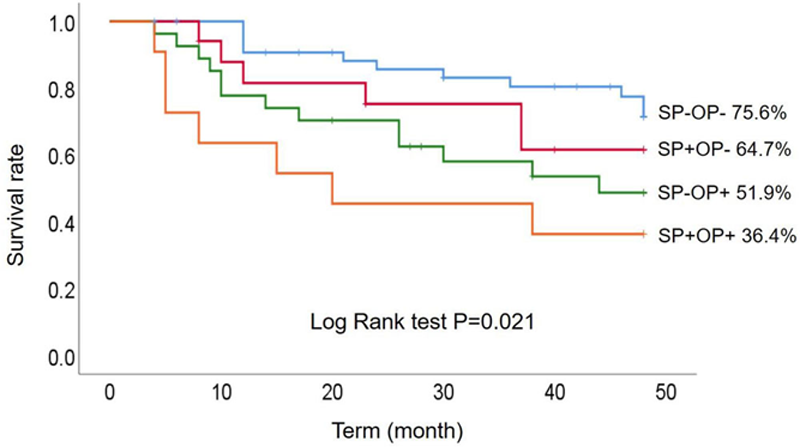

Background: Osteosarcopenia is defined as osteoporosis combined with sarcopenia. Both osteoporosis and sarcopenia are risk factors for falls and fractures in healthy individuals 1 . The relationships of falls and fractures to osteosarcopenia in rheumatoid arthritis (RA) patients are unknown.
Objectives: The synergistic effect of osteoporosis and sarcopenia and the impact of osteosarcopenia on falls and fractures in RA patients were investigated using four years of data from a longitudinal study.
Methods: The data from a prospective, observational study (CHIKARA study: UMIN000023744) were examined. The patients were divided into four groups according to their baseline status: no sarcopenia and osteoporosis (SP-OP-); only sarcopenia (SP+OP-); only osteoporosis (SP-OP+); and both sarcopenia and osteoporosis (SP+OP+). Sarcopenia was diagnosed by the criteria of the Asia Working Group on Sarcopenia 2014 2 . Patients with osteoporosis were defined as those having a therapeutic intervention for osteoporosis. The survival rate and Cox hazard ratio were analyzed using falls and fractures as endpoints, adjusted by age, sex, and body mass index.
Results: A total of 100 RA patients (female 78%, mean age 66.1 years) were enrolled. The number of SP-OP-, SP+OP-, SP-OP+, and SP+OP+ patients was 45, 17, 27, and 11, respectively. Their baseline characteristics are shown in
Baseline characteristics of the four groups
| SA-OP- | SA+OP- | SA-OP+ | SA+OP+ | P value* | |
| Female, % | 73.3 | 58.8 | 88.9 | 100 | 0.027 |
| Age, years | 63 (49, 72) | 69 (60, 79) | 73 (64, 75) | 73 (65, 81) | 0.008 |
| Disease duration, years | 4.4 (1.0, 8.4) | 4.0 (1.3, 8.9) | 7.6 (1.5, 14.5) | 10.5 (3.2, 26.5) | 0.035 |
| DAS28-ESR | 3.14 (2.66, 3.70) | 3.55 (3.01, 4.65) | 3.93 (3.28, 4.63) | 3.53 (2.48, 3.89) | 0.01 |
| mHAQ | 0.25 (0, 0.375) | 0.375 (0.125, 0.875) | 0.375 (0.125, 0.875) | 0.5 (0.125, 0.875) | 0.065 |
| MTX, mg/week, rate (%) | 8.4 ± 2.9 (86.7) | 8.7 ± 3.5 (70.6) | 8.3 ± 2.8 (92.6) | 6.8 ± 1.0 (90.9) | 0.388 |
| Glucocorticoid, mg/day, rate (%) | 3.7 ± 1.9 (20.0) | 6.3 ± 1.8 (11.8) | 4.0 ± 1.7 (44.4) | 3.8 ± 1.8 (18.2) | 0.400 |
| Body mass index, kg/m 2 | 23.4 ± 3.8 | 19.2 ± 2.3 | 21.7 ± 2.4 | 19.2 ± 2.0 | <0.001 |
Data are shown as mean ± standard deviation (SD) or median (25th, 75th percentile).
*: compared in four groups by Kruskal-Walls test.
Fall-free survival rates of the four groups.

Conclusion: The survival rates with the endpoints of falls and fractures in RA patients with osteosarcopenia were lower during the four-year follow-up. In particular, the risk of falls increased with the synergistic effect of osteoporosis and sarcopenia in RA patients.
REFERENCES:
[1]Dennison, E. M. et al. Fracture risk following intermission of osteoporosis therapy. Osteoporos Int 30 , 1733-1743, doi:10.1007/s00198-019-05002-w (2019).
[2]Chen, L. K. et al. Sarcopenia in Asia: consensus report of the Asian Working Group for Sarcopenia. J Am Med Dir Assoc 15 , 95-101, doi:10.1016/j.jamda.2013.11.025 (2014).
Disclosure of Interests: None declared.